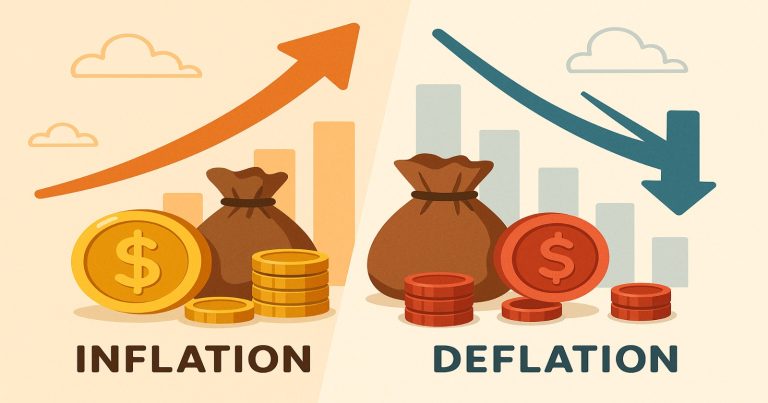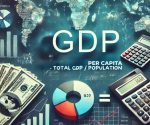The difference between inflation and deflation lies in the direction of price changes and their effect on an economy. Inflation describes the steady rise in the prices of goods and services over time, thereby devaluing money. Deflation, on the other hand, characterizes the steady decline of prices, which increases the buying power of money. Both phenomena have profound effects on economic growth, consumer behavior, investment strategies, and government policies. This article explores inflation and deflation in depth, examining their causes, advantages, disadvantages, and the similarities between the two.
Difference between Inflation and Deflation
Inflation occurs when constantly high prices are reflected over time, which reduces purchasing power. Deflation occurs when constantly falling prices result in economic shrinkage. These two phenomena are very important for the health of an economy and form a big influence on monetary policies. Such opposing economic forces exist between inflation and deflation, each with its own distinct characteristics. Their impact on various stakeholders, whether a business, consumer, or government, can best be explained by their differences.
| Aspect | Inflation | Deflation |
|---|---|---|
| Definition | A rise in the general price level of goods and services. | A decline in the overall price level of goods and services. |
| Effect on Money | Reduces the purchasing power of money. | Increases the purchasing power of money. |
| Economic Activity | Encourages spending and investment as future prices are expected to rise. | Discourages spending, as consumers expect prices to fall further. |
| Employment | Boosts job creation in the short term. | Often leads to layoffs and unemployment. |
| Impact on Debt | Reduces the real value of debt for borrowers. | Increases the real burden of debt for borrowers. |
| Causes | High demand, supply constraints, or loose monetary policy. | Weak demand, technological advancements, or tight monetary policy. |
| Consequences | Risk of hyperinflation if unchecked. | Risk of economic stagnation or depression. |
What is Inflation?
Inflation refers to the sustained rise in the general price level of goods and services in an economy. This refers to an environment of money whose value decreases over time, hence consumers spend much more to purchase the same things. Indices that inflate include the Consumer Price Index (CPI) and Wholesale Price Index (WPI).
Causes of Inflation
- Demand-Pull Inflation: If demand for goods and services is more than what is being supplied, then prices increase. Economic booms most of the time cause high demand and therefore inflationary pressures.
- Cost-Push Inflation: Increasing cost like labor or raw materials that makes production expensive make producers raise prices.
- Monetary Policy: Central banks printing too much money or lowering the interest rate causes inflationary pressure.
- Supply Chain Disruptions: Natural disasters, or any kind of geopolitical tensions that cause shortages in supply push prices higher.
Examples
One of the most notable instances of inflation was the 1970s oil crisis, where skyrocketing oil prices led to inflation worldwide.
Advantages of Inflation
Inflation, when moderate and controlled, can offer several benefits to an economy:
- Stimulation of economic activity: High inflation rates encourage spending and investment.
- Reduces real debt burden: Inflation eats into the purchasing value of fixed-interest debts for the borrowers.
- Rises asset value: Inflation boosts real estate, stocks, and any other investments.
- Promotes wage growth: Business is forced to raise wages when prices keep increasing.
Disadvantages of Inflation
Uncontrolled or high inflation can have negative consequences for economies and individuals:
- Erodes Purchasing Power: As prices rise, what consumers can buy with the same money falls.
- Creates income inequality: those living solely off of a fixed income and savings disproportionately bear its cost
- Distorts decision-making: businesses become short-term focused rather than long-term sustainable.
- Hyperinflation Risks: Extreme inflation pushes an economy towards Hyperinflation as seen in Zimbabwe 2008.
What is Deflation?
Deflation is the opposite of inflation and refers to a sustained decrease in the general price level of goods and services in an economy. It is characterized by negative inflation rates, indicating a contraction in prices. Deflation can occur due to factors such as reduced consumer demand, excess supply, technological advancements, or restrictive monetary policies. While deflation may seem beneficial on the surface as it increases the purchasing power of money, it can have adverse effects on the economy, including reduced spending, lower investment levels, and potential economic stagnation.
Causes of Deflation
- Demand Contraction: Recessions or economic slowdowns reduce consumer and business spending.
- Technological Advancements: Innovations can lower production costs, leading to falling prices.
- Tight Monetary Policies: High interest rates discourage borrowing and reduce spending.
- Excess Supply: When supply surpasses demand, prices drop.
Examples
The Great Depression of the 1930s is one of the most significant examples of deflation, where falling prices exacerbated economic hardship.
Advantages of Deflation
In some contexts, deflation can have positive effects:
- Boosts Consumer Purchasing Power: Falling prices make goods and services more affordable.
- Encourages Savings: Lower prices incentivize individuals to save for future consumption.
- Favors Creditors: Lenders benefit as the value of money rises.
Disadvantages of Deflation
Despite its occasional benefits, deflation is generally considered harmful to economies:
- Discourages Spending: Consumers delay purchases, expecting prices to drop further, reducing overall demand.
- Increases Real Debt Burden: Borrowers face higher repayments in real terms, often leading to defaults.
- Leads to Unemployment: Businesses cut costs by laying off workers during periods of deflation.
- Stifles Economic Growth: Prolonged deflation can lead to a vicious cycle of reduced spending and investment.
Similarities Between Inflation and Deflation
Although inflation and deflation are opposites, they share some similarities in their influence on the economy:
- Purchasing Power: Both conditions reduce the purchasing power of consumers but on different sides of the scale.
- Monetary Policy: Central banks keep track of and control both conditions because they threaten stability in the economy.
- Investment: Both conditions create uncertainty that deters long-term investment.
- Economic Indicators: A condition of inflation and a condition of deflation are barometers to tell if an economy is normal or not and to prompt action accordingly.
Difference between Inflation and Deflation FAQs
What are the main differences between inflation and deflation?
Inflation involves rising prices, reducing purchasing power, while deflation entails falling prices, increasing money’s value. Both affect spending, debt, and investment differently.
How do inflation and deflation impact consumers?
Inflation increases costs for consumers, while deflation makes goods cheaper but may discourage spending due to expectations of further price drops.
Why is deflation considered harmful?
Deflation discourages spending, increases real debt burdens, and often leads to unemployment, causing economic slowdowns.
What role do central banks play in managing inflation and deflation?
Central banks adjust interest rates and control money supply to maintain price stability and prevent extreme inflation or deflation.
Can inflation and deflation occur together?
Yes, in specific sectors or conditions, parts of the economy may experience inflation while others see deflation, a phenomenon known as “biflation.”


